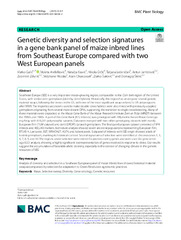Приказ основних података о документу
Genetic diversity and selection signatures in a gene bank panel of maize inbred lines from Southeast Europe compared with two West European panels
| dc.creator | Galić, Vlatko | |
| dc.creator | Anđelković, Violeta | |
| dc.creator | Kravić, Natalija | |
| dc.creator | Grčić, Nikola | |
| dc.creator | Ledenčan, Tatjana | |
| dc.creator | Jambrović, Antun | |
| dc.creator | Zdunić, Zvonimir | |
| dc.creator | Nicolas, Stephane | |
| dc.creator | Charcosset, Alain | |
| dc.creator | Šatović, Zlatko | |
| dc.creator | Šimić, Domagoj | |
| dc.date.accessioned | 2023-06-28T12:24:56Z | |
| dc.date.available | 2023-06-28T12:24:56Z | |
| dc.date.issued | 2023 | |
| dc.identifier.issn | 1471-2229 | |
| dc.identifier.uri | http://rik.mrizp.rs/handle/123456789/1148 | |
| dc.description.abstract | Southeast Europe (SEE) is a very important maize-growing region, comparable to the Corn belt region of the United States, with similar dent germplasm (dent by dent hybrids). Historically, this region has undergone several genetic material swaps, following the trends in the US, with one of the most signifcant swaps related to US aid programs after WWII. The imported accessions used to make double-cross hybrids were also mixed with previously adapted germplasm originating from several more distant OPVs, supporting the transition to single cross-breeding. Many of these materials were deposited at the Maize Gene Bank of the Maize Research Institute Zemun Polje (MRIZP) between the 1960s and 1980s. A part of this Gene Bank (572 inbreds) was genotyped with Afymetrix Axiom Maize Genotyping Array with 616,201 polymorphic variants. Data were merged with two other genotyping datasets with mostly European fint (TUM dataset) and dent (DROPS dataset) germplasm. The fnal pan-European dataset consisted of 974 inbreds and 460,243 markers. Admixture analysis showed seven ancestral populations representing European fint, B73/B14, Lancaster, B37, Wf9/Oh07, A374, and Iodent pools. Subpanel of inbreds with SEE origin showed a lack of Iodent germplasm, marking its historical context. Several signatures of selection were identifed at chromosomes 1, 3, 6, 7, 8, 9, and 10. The regions under selection were mined for protein-coding genes and were used for gene ontology (GO) analysis, showing a highly signifcant overrepresentation of genes involved in response to stress. Our results suggest the accumulation of favorable allelic diversity, especially in the context of changing climate in the genetic resources of SEE. | sr |
| dc.language.iso | en | sr |
| dc.publisher | Springer Nature | sr |
| dc.relation | This research was funded by the EU project Biodiversity and Molecular Plant Breeding, Grant Number KK.01.1.1.01.0005, of the Centre of Excellence for Biodiversity and Molecular Plant Breeding (CroP-BioDiv), Zagreb, Croatia. | sr |
| dc.rights | openAccess | sr |
| dc.rights.uri | https://creativecommons.org/licenses/by/4.0/ | |
| dc.source | BMC Plant biology | sr |
| dc.subject | maize | sr |
| dc.subject | selective sweep | sr |
| dc.subject | diversity | sr |
| dc.subject | gene ontology | sr |
| dc.subject | genetic resources | sr |
| dc.title | Genetic diversity and selection signatures in a gene bank panel of maize inbred lines from Southeast Europe compared with two West European panels | sr |
| dc.type | article | sr |
| dc.rights.license | BY | sr |
| dc.citation.volume | 23 | |
| dc.citation.spage | 315 | |
| dc.identifier.doi | 10.1186/s12870-023-04336-2 | |
| dc.identifier.fulltext | http://rik.mrizp.rs/bitstream/id/6146/2023-BMC_Plant_Biology-s12870-023-04336-2.pdf | |
| dc.type.version | publishedVersion | sr |


